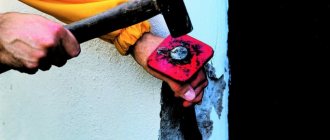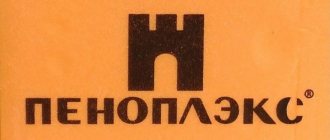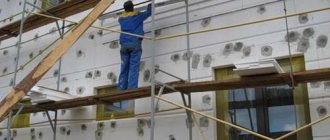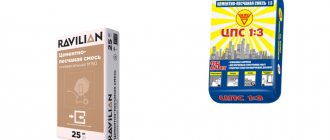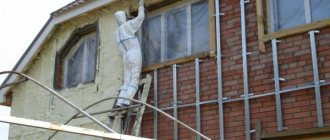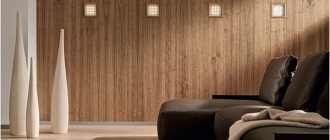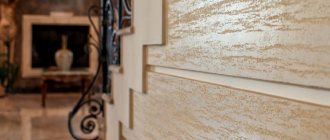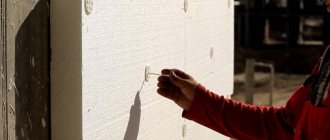In addition to decorative finishing of the house, attention should be paid to the insulation of external walls. Thermal insulation is needed not only for a private home, but also for a summer house, cottage or garage. You need to start with choosing insulation. This material should reliably retain heat inside the building, increase comfort and provide protection for the external walls of the building from various influences. To decide which is the best insulation for the facade, you should familiarize yourself with all the options. It will be much easier to choose the best type if you study the advantages and disadvantages of each variety. Today we will talk in detail about the best way to insulate a facade.
Foam plastic in the interior and on the facade
Buildings with facades decorated with foam plastic are exclusive and romantic. The upper part of the wall of the house with decoration in the form of an entablature adds mystery, the columns with a figured capital turn the house into a real classical structure, and the arched doorway framed by a decorative archivolt completes the overall bright impression.
For interior decoration, stucco foam is used on the ceiling and walls. Any modern solution is appropriate in the ceiling design. The decoration around the chandelier and illuminated cornice moldings look attractive. The wall decor assumes a classic style.
So, decorating a house or apartment with polystyrene foam is quite accessible, inexpensive and practical. Working with him, you can discover your talents as a designer and subsequently be proud of your own achievements.
https://youtube.com/watch?v=T_LkShpDoOc
Product categories
Product categories
Looking for energy efficient solutions?
Pay attention to FORUMHOUSE geothermal heat pumps
Ground source heat pump EU (start/stop)
Geothermal heat pump IQ (pseudo-inverter)
IQ ground source heat pump (inverter)
When we hear about the insulation of building envelopes, two options immediately come to mind: a “wet” façade (WFC) and a ventilated façade, which is also called a curtain façade. But today, façade thermal panels, otherwise known as ready-made facades, are becoming increasingly common among private developers. Let's figure out what characteristics allowed thermal panels to move from the category of single examples to the category of popular facade finishing.
Content
Ecowool
The name “ecowool” refers to a crumbly material consisting of cellulose with the addition of flame retardant compounds. Filling the cavities with ecowool provides a continuous thermal insulation layer that penetrates into hard-to-reach cracks and corners. To insulate the facade, both dry and wet-adhesive installation methods are used.
In the first case, a box-shaped structure is mounted on the facade, into which the material is blown dry. In the second, an adhesive composition and a moisturizer are mixed into the material, spraying the resulting mass on the surface using blowing machines, and after drying, it is leveled along the guides with a trimming knife. A layer of ecowool 5 cm in thermal conductivity replaces one-and-a-half brick laying. After the composition has hardened, the insulation can be lined externally using various materials, including siding.
Despite the difficulties in applying ecowool to vertical surfaces, it has its advantages: the ability to be used on any curved and complex shapes and minimal shrinkage during operation.
As you can see, there are many technologies for finishing a façade using insulation, which makes it possible to take into account its original characteristics and the conditions of future operation of the building as much as possible. Properly selected materials and finishing technology contribute to the effective protection of building walls from external influences and optimization of its internal microclimate.
Popular methods of insulating facades
Modern builders use various methods of external wall insulation. Each method has its pros and cons. The “wet facade” technology has become a very popular method, what is its specificity:
- The wall is pre-cleaned and prepared.
- The next step is to apply a layer of glue of a maximum of three centimeters.
- Laying insulation.
- Applying another adhesive layer.
- Installation of reinforcing mesh.
- Applying plaster.
- Primer.
- Coloring.
Installation of an insulator under plaster is suitable for all types of mineral wool and foam plastic.
Installation of decor on the facade of the house
When carrying out such work, you must follow the algorithm of actions. First you need to carry out preparatory work with the surface on which the decor will be attached. To do this, remove the remains of old plaster from the surface, remove dust and dirt
Armed with facade plaster, it is important to eliminate all internal irregularities
Advice! If voids are identified, you can use a cement solution to level them.
Then they mark the places where the decorative façade elements will be attached. If some elements of the product protrude by 10-15 centimeters, you will have to strengthen the structure with dowels driven into the walls of the house in advance. Before starting work related to the design of the foam plastic facade, professionals recommend checking the evenness of the surface.
The next stage of installation work will be diluting the glue and applying it to the back side of the decorative fragments
When attaching them to the wall, a little force will be required to improve the quality of adhesion of the glue to the surface being designed.
Attention! Be careful when working with decorative fragments, as the product is fragile. The installation process is completed by sealing the fastener gaps with foam or sealant. After it is completely dry, you can remove any remaining residue with a spatula.
After it is completely dry, you can remove any remaining residue with a spatula.
The installation process is completed by sealing the fastener gaps with foam or sealant. After it is completely dry, you can remove their remains with a spatula.
Next, a high-quality primer of all decorative elements is carried out using a special solution. At the final stage, the manufactured polymer decor is painted with acrylic dyes according to the design project. To increase the service life of products, professionals recommend painting 2-3 times.
Applying additional protection to façade decor is a mandatory stage of finishing work. This will protect the finished product from sudden temperature changes and high humidity.
How to choose?
The market is rich in a variety of facade panels. How to choose those that will last a long time and will not require overpayments. To do this, you must follow the usual rules:
Prices for facade thermal panels
Video - Clinker thermal panels
If you do everything correctly, then the façade panels with insulation will reciprocate your feelings and will last for many years without breakage or deformation. And your house will always look like it was just built and have its own style and uniqueness.
Indeed, in your work on the design of the facade, you can be guided by a mixture of styles, simultaneously using, for example, plaster and panels, or natural stones at the bottom - panels at the top and so on. There is scope for imagination and the embodiment of the most unusual desires for the appearance of the house. But it is important that in addition to appearance, using this type of facade panels you simultaneously insulate it and also reduce the level of noise penetration into the house. All these factors will help maintain home comfort and a comfortable stay within your own walls.
Source
Types of facade panels
All types of facade insulated panels for exterior decoration of a house are characterized by ease of installation and low heat loss. But each has its own technological advantages.
Thermal panels
Thermal panel - a layer of insulation on the bottom, facing material on top.
They are used for insulation simultaneously with facing work. A wide variety of modifications and shades allows you to select the appropriate building material for upgrading office and industrial buildings, shops and medical institutions, residential high-rise buildings and country buildings.
They produce products of different thicknesses - up to 8 cm. When choosing, they are guided by the climatic characteristics of the region: for the south, thinner models are needed, for the middle zone - thicker, and residents of Siberia should prefer 8-cm options.
The outer layer is made of metal, polyurethane, clinker tiles. Thermal protection slabs coated with porcelain stoneware imitate stonework, which gives the building a solid appearance. Polystyrene foam or more expensive and high-quality polyurethane foam is used as the inner layer. But external thermal facade panels for houses with such insulation have a significant drawback - low resistance to open flame.
Sandwich panels
Sandwich panels are used in the construction of finished structures
These are three-layer “pies”, which consist of an insulating layer and a facing coating on both sides. These panels can be used to build new houses or insulate existing ones. For cladding layers, manufacturers use wood shavings, less often metal. Typically, sandwich panels require additional finishing, as they do not look presentable. But you can find on sale slabs with a decorative coating that imitates the surface of wood or stone.
Warm sandwich panels for exterior walls of a house are characterized by lightness, durability, and increased energy efficiency. They are produced by pressing internal insulation and sheathing.
When choosing, emphasis should be placed on the qualities of the warm layer:
- Mineral wool does not burn, is environmentally friendly, and does not attract mice, rats and insects. Among the disadvantages, the most important is instability to moisture, so you need to monitor the tightness of the coating.
- Polystyrene is a durable building material with high heat-shielding properties that is not afraid of moisture. It is adversely affected by the sun's rays, but thanks to the external cladding, this flaw is leveled out. The insulation is not fireproof; when burned, it emits harmful substances, and rodents live in it.
- Polyurethane foam is not afraid of moisture even with direct contact with water. The material weighs little, the panels are easy to transport and install on walls. Plus - the load on the foundation is reduced. The thermal conductivity of building materials is 1.5–2 times lower than that of other insulation materials.
- Polyisocyanurate (a type of polyurethane foam) self-extinguishes when ignited. It is increasingly used as the inner layer of sandwich panels. The building material does not mold and is not susceptible to fungal attack. Among the disadvantages is the risk of damage by rodents.
Thermal insulation panels under plaster
Panels for plaster do not have a decorative layer
Panels for plaster for insulating the facade of a house are produced on the basis of foam sheets made of marble or quartz chips of a half-centimeter fraction. Their thickness varies between 5–10 cm. The slabs successfully resist the negative effects of external factors and are attached to the external walls using an adhesive composition for foam plastic. An additional advantage is the ability to create a visually seamless surface.
The best way to insulate a house: criteria for choosing insulation
When choosing a material for insulating external walls, you should take into account its scope of application, technical characteristics, affordability, expert opinions and reviews of people who have already used it.
Among the technical characteristics, the most important are the following:
- thermal conductivity - the ability of a material to transfer heat, the lower this indicator, the better, thermal conductivity directly depends on the thickness of the insulation and its density;
- weight - the higher the density of the insulation, the heavier it is, this complicates its installation, since, in addition to adhesives, it is necessary to use anchor dowels, the weight of the material must also be taken into account when calculating the loads of facade finishing on load-bearing structures;
- environmental friendliness - the material should not emit harmful substances even when heated for a long time in direct sunlight; biologically neutral and necessarily non-toxic insulation materials are considered optimal;
- fire safety - materials for insulating walls outside must be non-flammable or self-extinguishing, this will prevent the spread of fire along the facade in the event of a fire;
- waterproofness - insulation of walls from the outside is carried out with materials that do not absorb moisture, otherwise it is necessary to additionally use a moisture-proof membrane, because some insulation materials, when wet, lose their thermal insulation characteristics and quickly become unusable;
- vapor permeability - for “wet” facades this parameter is not particularly important, but it should be taken into account when arranging curtain wall structures and for “breathable” wall materials;
- durability - the service life of insulation is in the range of 30-70 years.
The thermal conductivity of home insulation depending on the density of the material can be seen in the table below.
| Material | Thermal conductivity of materials, W/m*S | Density, kg/m³ |
| Polyurethane foam | 0,041 | 30 |
| 0,035 | 40 | |
| 0,029 | 60 | |
| 0,020 | 80 | |
| Expanded polystyrene | 0,037 | 10-11 |
| 0,035 | 15-16 | |
| 0,034 | 16-17 | |
| 0,033 | 25-27 | |
| 0,030 | 35-37 | |
| Extruded polystyrene foam | 0,034-0,028 | 28-45 |
| Basalt wool | 0,039 | 30-35 |
| 0,037 | 34-38 | |
| 0,035 | 38-45 | |
| 0,033 | 40-50 | |
| 0,030 | 80-90 | |
| 0,029 | 145 | |
| 0,027 | 120-190 | |
| Ecowool | 0,041 | 35 |
| 0,039 | 50 | |
| 0,037 | 65 | |
| 0,033 | 70 | |
| Tepofol (penofol) | 0,037-0,051 | 45 |
| 0,038-0,052 | 54 | |
| 0,038-0,052 | 74 |
Important!
Do not think that the thermal conductivity of a material depends solely on its thickness. Some people mistakenly believe that the thicker the insulation, the better. Excessive thickness can lead to disruption of the natural removal of steam from the room, which will cause the formation of condensation on the walls. As a result, mold and mildew may develop on them.
Features of thermal facade panels
Thermal facade panel consists of a facing layer, behind which the insulation is hidden
Structurally, all types of thermal facade slabs are identical: they consist of two or three layers of facing building material, which hides the insulation from the inside. The front side is usually decoratively finished. The greatest interest from home owners is in panels designed to look like clinker tiles, bricks, and natural stone.
Advantages and disadvantages of application
Thermal facade panels keep you warm in cold weather and cool in the summer heat. The insulating effect of such cladding implies significant savings in energy resources. High thermal insulation properties make it possible to recoup costs within three to four heating seasons.
Another advantage is the low weight of façade thermal insulation panels. They do not exert a significant load on the foundation. Lightweight elements are also easier to install: most products are attached manually without the use of special equipment.
Thermal facade slabs also have other advantages:
- long service life;
- mechanical strength;
- resistance to temperature changes and exposure to sunlight;
- moisture resistance;
- immunity to mold and mildew;
- fire safety;
- environmental friendliness.
The wall surface must be thoroughly prepared before fixing the slabs.
Properties and characteristics
The facade panel can be selected according to three parameters - temperature range, length and width
Cladding panels have the following parameters:
- length – 100–125 cm;
- width – 42–46 cm;
- temperature range - from minus 50 to plus 60 degrees.
The thickness of the products depends on the number of layers and insulation. Wall panels for insulation are durable. According to the manufacturers, they will last for more than fifty years without loss of useful qualities and original shade.
We are approaching the finish line
The last two stages of installing facade tiles with insulation are grouting. A grout layer is applied to the entire surface and rubbed over the entire surface using a brush. The jointing must be carried out no less than a day after shrinking with glue (do not forget that between these two stages there is still fastening with dowels). After grouting, you need to thoroughly wash the surface with a sponge. Grouting joints and washing them is not a quick task, but what can you do, it’s one of the disadvantages.
Seams need to be unraveled one day after shrinkage on the glue.
Let's summarize our review and short instructions for installing slabs for facade insulation.
PROS:
- Easy installation, no wet processes;
- Attractive appearance imitating brick or stone;
- Good thermal insulation.
MINUSES:
- Higher cost compared to, say, “Bark Beetle” plaster;
- The need to thoroughly grout the joints, followed by washing the solution.
If you like to experiment, why not use warm façade panels? But this will be a rather long experiment. Wikipedia says that the panels last from 50 to 100 years. So, our grandchildren will probably be able to find out about the results.
Distinctive features of foam decoration
Foam decorations for facades are produced by pouring into special molds.
Attention! When installing foam plastic products on the facade of a house, it is necessary to use a special protective coating. It is necessary to increase the resistance of foam plastic products to external negative influences, increase its strength, and extend its service life.
It is necessary to increase the resistance of foam plastic products to external negative influences, increase its strength, and extend its service life.
There are many reasons why ordinary buyers should purchase decorative elements made of foam plastic.
Manufacturers offer facade decorative elements in a different color range, and at very affordable prices.
Polystyrene foam does not have high reliability, mechanical resistance, or durability, but with the help of modern technologies all these minor shortcomings can be easily eliminated.
Advice! Facade decor made of expanded polystyrene (foam) without additional processing is appropriate only in places that are reliably protected from the effects of the environment.
For example, you can use façade elements made of foam plastic to decorate the cornice, which is located under the roof slope. This area is reliably protected from moisture, and the material is not at risk of mechanical damage.
The facade decor made of polystyrene foam, made in the form of arches, must be treated so that weather conditions do not spoil its appearance. Sometimes decorative elements made of polystyrene foam are used in conjunction with other materials that will allow the decoration to be used for much longer.
Among the recent fashion trends, we note the option of non-standard decoration of the external walls of a private house.
Foam plastic decor for facades is lightweight and easy to process, which is why the material is in demand among architects. It is the decor made of foam plastic that allows the owners of country cottages to turn original design ideas into reality.
Density indicators
See also
Covering the gable with siding: do-it-yourself finishing technology
It is difficult to say unequivocally which insulation is better for a ventilated facade, or for plaster finishing. It all depends on the specific situation, the material from which the house is built, and the finishing used.
The density of the insulation for the facade also plays an important role.
You should determine in advance what density of insulation is suitable for external insulation of a house, as well as what is best to use.
The materials used for thermal insulation of walls must have high density as well as sufficient rigidity. Soft sheets are not suitable. In theory, you can take them. But in practice the result will be disappointing. After all, such insulators can slip, settle, and also become deformed. As a result, cold bridges are formed.
If we talk about standard foam plastic boards that are suitable for thermal insulation, then the minimum density value will be 10-20 kg/m3. But this is the bare minimum that can be considered.
In reality, aim for the highest possible density.
For example, for mineral wool it is 100-200 kg/m3. And polystyrene foam is 100-150 kg/cm. If you use polyurethane foam, then due to the characteristics of the material, the permissible density will be 40-80 kg/m3.
Features of manufacturing foam decor
There are strict requirements for the polymer that is made for facade finishing of houses. The material for production is PSB 25f. It has all the most important characteristics and qualities in order to be used in exterior wall decoration. Thanks to modern automatic equipment, you can burn and cut contours, create products of different sizes and shapes. In order to achieve reliable protection of the created element from high humidity and sudden temperature changes, sheets of polymer material are coated with a reinforcing compound. For example, you can treat a sheet of polymer material with mineral mixtures created on the basis of acrylic paint.
Next, the sheet is sent for drying. In order for the polymer not to lose its technical and operational characteristics, it is necessary to withstand a certain temperature regime. As soon as the protective layer has dried, the workpiece is sent to the last stage of production: stripping and polishing.
Why choose Thermopan
If you want your home to be cozy not only inside, but also outside, and at the same time do not want to spend a lot of money on it, TERMOPAN facade panels are the ideal solution.
TERMOPAN facade polyurethane panels are a modern product available to a wide range of buyers, the quality of which meets the requirements of the modern construction market. Our company is pleased to offer its customers a wide selection of facade panels, metal panels, as well as facade thermal panels. The unique properties of wall panels make it possible to solve a number of problems - this includes insulating the house, ensuring fire safety and the aesthetic appearance of the building facade.
TERMOPAN facade panels, developed using Japanese technologies, incorporate the latest achievements in the field of lightweight building materials with a thermal insulation function.
Possessing properties such as thermal insulation, airtightness, moisture resistance, fire resistance and being an environmentally friendly material, TERMOPAN wall panels meet international design standards and energy saving concepts. They can confidently be classified as energy-saving decorative wall panels.
The basis of the panel is a molded steel sheet, additionally coated with an aluminum-zinc protective layer and seven layers of special resin paint. The internal filling is a polyurethane foam layer, protected on the back side by aluminum foil, which is reflective, retains heat and provides additional protection from dampness. With TERMOPAN thermal insulation panels you no longer have to worry about the condition of the building facade.
Today, TERMOPAN brand panels are available to a wide range of consumers, since the product range includes models with a wide variety of designs, and is selected in such a way as to satisfy the needs of any most demanding consumer. It is important for us that as many people as possible make their home more comfortable and cozy, thanks to TERMOPAN panels.
You will find all possible options for façade panels in the catalog on our website, and here you can easily leave a request to call a measurer and familiarize yourself with the terms of purchase and sale of products. You can also buy façade panels in our online store.
Source
Technology for installing foam plastic on the facade
To carry out insulation, professionals advise laying polystyrene foam on the façade in a continuous layer. Facade frost-resistant adhesive without the presence of solvents is used as a mounting agent. In addition, you will need disc-shaped dowels and polyurethane foam to form the seams.
The work is carried out according to the following algorithm:
Preparation of the façade surface. To do this, the old layer of finishing is removed from it, the walls are leveled as much as possible, and all existing cracks are filled without fail. A horizontal stop is fixed at the bottom of the wall, which is a metal corner that prevents the foam from sliding off the wall. Such a shelf should be the same thickness as the insulating material. It is attached to dowels in increments of 30 cm. The surface is treated with a primer with deep penetration and antiseptic components added to it. Prepare the adhesive mass in accordance with the attached instructions and apply it to the facade foam. The layer is applied evenly along the entire perimeter of the slab, only in the middle a spot design is possible. Press the foam sheet against the wall and hold it in this position for about a minute. In this case, all excess that protrudes beyond the edges is removed immediately. Advice! During application, the glue must be positioned so that 5 cm remains to the edge. This makes it possible not to remove excess during installation.
Pasting slabs using the same technology over the entire wall surface. All resulting seams are sealed with polyurethane foam.
After the foam has set, its excess is cut off so that the gaps are flush with the surface of the slab. Important! It is better not to leave gaps wider than 2 mm.
Another layer of foam is glued onto the dried finish so as to cover the existing seams. After the glue has completely hardened, the foam is fixed with disc-shaped dowels.
Wet method
Work on thermal insulation of facades begins with preparing the surface of the walls. They need to be cleaned and cracks and crevices filled with putty. All damaged sections of the wall must be restored.
If a thin layer of the mixture, no more than 16 mm, is intended to be applied to the walls, then it is not necessary to use reinforcing mesh. Without reinforcement, you can apply a layer of plaster no more than 5 cm thick. A thicker layer of plaster needs reinforcement. If there is a need for additional reinforcement, then it is better to give preference to fiberglass mesh.
The finished plaster composition is applied to the walls evenly, maintaining the thickness at an equal level. Level the surface using construction rules.
To insulate wooden walls, shingles are constructed; it serves as a reinforcing layer for plaster.
The work is carried out by professional craftsmen, this is considered a disadvantage in using the method. The disadvantages include the inability to carry out work at temperatures below +5° C.
Nuances when installing façade foam plastic
Any construction process has its own nuances that must be observed. There are also special features for insulating the façade with polystyrene foam.
For example, if communications have not yet been connected to the house, before installing the insulation, it is necessary to mark their places with pipes or something else, so that when attaching the foam plastic, the dowel is not driven into the void or too close to the edge.
When working with polystyrene foam, it is worth remembering that all seams must be treated with polyurethane foam to prevent them from turning into cold bridges and moisture from getting inside. This is done even if the sheets were tightly fitted to each other.
Additional fixation of foam plastic with dowels is a necessary step when insulating, but when choosing fastening material it is important not to make a mistake. So, the length of the fastenings should be such that they have the opportunity to penetrate through the insulation layer and linger in the facade
For example, brick walls require a dowel length 9 cm longer than the foam layer, and concrete walls - 5 cm. The situation is most difficult with porous building materials, since it is quite difficult to bury fasteners in them. For this option, fungi are suitable, which can penetrate 12 cm into the base.
To avoid damage to the foam sheet, the dowels are not driven too deeply into the insulation. The optimal depth is 1 cm. To prevent the slab from cracking, the dowels are driven 20 cm from the edge.
To reliably strengthen a sheet of foam plastic, 5–6 pieces of fasteners are needed, and they should be located at approximately the same distance from each other. The glue on the back side should occupy approximately 50% of the total sheet area.
The main thing after insulating the facade is not to leave the foam for a long time without finishing cladding. Although this material is highly resistant to external influences, it can quickly become unusable from ultraviolet rays.
Mixed
See also
Siding fence: pros and cons, how to make it yourself
As for the mixed category, this includes asbestos mixtures with the addition of dolomite, perlite or mica. The composition also contains mineral components that act as a connecting link for the base.
The output will be a mass resembling a thin dough. Before hardening, the composition is applied to the surface, and the hardening process begins.
In terms of heat resistance, the insulator is excellent. Can withstand temperatures up to 900 degrees Celsius. But at the same time it absorbs moisture well. When used as façade insulation, waterproofing is a must.
Dust from asbestos is harmful to humans. So here, too, you can make claims about the material.
Insulation options
The installation of insulating panels for external walls depends on how flat the surface is on which the slabs will be installed. The cladding of other areas of the house, in addition to the facade and sides of the building, has certain features.
Insulation of uneven walls
To level the walls, the frame method of laying panels is used
When installing slabs on walls, you need to take into account unevenness leading to deformation of thermal panels. To avoid this, a frame installation method is used. The sheathing is made of wood or metal, the second option is preferable. If wood is used, the beams are treated with an antiseptic.
The length of the horizontal and vertical steps of the frame lattice is selected in accordance with the dimensions of the wall slabs; the location of the fastening holes must coincide with the centers of the bars or metal profiles. In order for the panels to fit well, the frame must create a flat plane. If there is a risk of heat and moisture retention in the space between the lathing base and the panels, it is filled with construction foam. If it is impossible to install a frame grid, the wall is leveled with cement. This method is less economical.
Fastening panel elements to the sheathing:
- Thermal panels are laid from the bottom corner to the top.
- If corner parts are available, they are secured first. If not, the end parts of the slabs are sawed down to join at an angle of 45 degrees.
- Installation of the main panels on the sheathing is carried out using self-tapping screws. Their length should exceed the thickness of the product by 4–5 cm.
- Each subsequent row is mounted with offset vertical seams to improve tightness. To save money, they take extra material from panel scraps. To adjust it to size, the front part of the slab is sawn with a grinder with a disc corresponding to the external material; the insulation is easily cut with a knife.
Insulation of a flat facade
With smooth walls, installation with glue or dowels is possible
The slabs can be installed without lathing. If installation is carried out directly on a wall made of brick or concrete blocks, the panels are attached to the supplied dowel nails. Their length should be 4–5 cm greater than the thickness of the cladding. The locations for drilling holes in the slabs are usually already marked.
Begin laying from the bottom wall corners upward. In general, the process is similar to installing slabs on sheathing.
Before installation, the space between the wall surface and the slabs can be filled with polyurethane foam to provide additional heat-insulating properties. You need to find the most protruding place on the wall and level the surface along it. But it takes a lot of time, effort and money. It’s easier to install the frame and attach the slabs to it, and then either foam the space inside or leave a ventilated layer.
Examples of cladding
It is possible to choose panels of any size and shape
Facade panels with insulation can be used to decorate not only walls; they have proven themselves to be excellent when cladding plinths, eaves overhangs, columns and architectural extensions.
For the base, it is preferable to choose a material that is additionally reinforced with compressed metal or plastic bushings. These slabs differ in size - they are smaller than wall slabs.
If you are lining an eaves overhang, a terrace or balcony ceiling, or a porch canopy with insulated panels, it is necessary to leave holes for ventilation. The simplest option is to create a gap between the panel and the wall or build in grates for aeration. For such work, be sure to choose panels with moisture-resistant insulation.
The cladding of square columns and flat-walled architectural forms is carried out according to the principle of facade finishing. But for rounded parts you need to choose elements of the appropriate shape.
In general - about panels
All panels for the facade can be divided into 2 groups:
If you classify them according to their characteristics, you get a huge variety of panels for exterior decoration.
Table 1. General classification of facade panels.
| Signs | Kinds |
| By format | Long planks, rectangles, narrow planks, square design |
| By appearance | Imitation of the texture of stone, wood, brick, painting, plaster |
| For thermal insulation | Thermal panels, sandwiches with built-in insulation, without insulation |
| By type of fastening | Grooves, locks, without fixation |
| Based on materials | Metal, composite, plastic, wood, polymers |
Of course, consumers much more often choose panels with insulation, because with such finishing they seem to kill two birds with one stone - they both insulate the home and give the house a beautiful appearance. Much depends on the climatic conditions of the region of residence. If it is warm there all year round, then insulation is not needed.
Styrofoam molding
Stucco molding is an accessible and inexpensive type of interior design. For centuries it was made from gypsum, but foam plastic, synthesized by chemists in the middle of the last century, won. It can imitate any architectural style.
Today you can buy cornices, columns, moldings (overhead convex strips), and other products for decoration made of granular or smooth polystyrene, unpainted or imitating wood, marble, stone.
Foam stucco cannot be called particularly durable. But it is ideal for those who like frequent repairs and in rooms with a non-standard microclimate: it is used to cover walls in a damp bathroom or basement, where other materials quickly deteriorate.
Insulation of external walls with mineral wool
| Name | Price |
| Thermal calculation | For free |
| Geodetic survey | 20 rub/m2 |
| Design work | 70 rub/m2 |
| Installation/dismantling of frame scaffolding | 120 rub/m2 |
| Marking walls for brackets | 50 rub/m2 |
| Installation of brackets | 150 rub/m2 |
| Attaching extension cords | 100 rub/m2 |
| Installation of the first layer of insulation | 200 rub/m2 |
| Installation of the second layer of insulation | 100 rub/m2 |
| Installation of guides | 200 rub/m2 |
| Fastening the facing layer | 600 rub/m2 |
| Construction of a subsystem for a parapet cover | 500 rub/m2 |
| Installation of parapet sill | 400 rub/m. |
| Installation of ebbs, slopes, drips | 350 rub/m. |
Distinctive characteristics of foam decorative elements
The decor of the facade of a polystyrene foam house has some distinctive characteristics:
- affordable price of products;
- ease and speed of installation of finished products;
- the possibility of decoration without the involvement of specialists;
- minimum weight that does not lead to additional load on the foundation of the building;
- long operational service life;
- excellent water-repellent characteristics;
- increased strength;
- environmental friendliness and resistance to decay processes
Installation work associated with the use of polymer makes it possible to carry out installation in any climatic conditions, regardless of temperature indicators.
Metal panels with insulation for facades - parameters and properties
When choosing an option, you should consider, first of all, the design requirements and properties of a particular structure, namely:
The main parameters and properties of the panels analyzed and taken into account when designing a sandwich panel building and developing specifications are as follows:
In addition to these parameters, attention should be paid to the influence of certain characteristics of sandwich panels and the method of their fastening on the appearance of the building. This is especially important for metal panels with insulation for the facade of a house, since the roofs of residential buildings usually have a slight slope and therefore remain practically invisible. As for the façade of the building, it is the most visible and the most important.
From an architect's perspective, the front view is of particular aesthetic value and is therefore the most common subject of discussion, with decisions often made only after consultation with the home owner. Other façade walls, especially in industrial buildings, can be quite monotonous and must meet primarily technical parameters, without much attention to aesthetic properties.
Types of materials
The most popular and widespread insulation materials include:
- Polystyrene foam (expanded polystyrene);
- Penoplex (extruded polystyrene foam);
- Mineral wool;
- Various sidings and panels.
Types of popular insulation: polystyrene foam, mineral wool, panels, penoplex
When insulating the facade of a cottage or house, you can combine various facade insulation materials, and also lay them with different thicknesses. For example, the insulation layer on the south wall of the house may be thinner than on the rest.
Insulation of facades with foam plastic
Polystyrene foam is the most traditional and well-known material, which has a very low specific gravity, moisture resistance and low thermal conductivity, since it consists of 90% air bubbles. Polystyrene foam as insulation has the advantage of low cost. However, polystyrene foam is easily damaged by rodents.
Foam is cheap and easy to install, however, it is easily damaged
Insulation of the facade with penoplex
Penoplex is the domestic name for extruded polystyrene foam. Like polystyrene foam, it is produced from polystyrene by foaming, but using a slightly different technology.
Penoplex has higher sound insulation
Polystyrene foam is produced by sintering individual granules, but in the case of penoplex, it is not individual granules that undergo transformation, but a single liquid substance. Therefore, it has a solid, uniform and denser structure, consisting of the smallest closed cells.
Penoplex has higher sound insulation, and polystyrene has breathability, which allows the walls to “breathe”.
Insulation of the facade with mineral wool
Mineral wool is characterized by excellent soundproofing and fire resistance
Mineral wool is divided into 3 types:
- fiberglass;
- stone or basalt;
- slag.
Glass and stone wool are used for thermal insulation of facades. It is characterized by increased strength, moisture resistance, good resistance to mechanical stress, sound-absorbing properties, and fire resistance (can withstand temperatures up to 1000°C).
Insulation of the facade with panels
The panels will help not only insulate, but also improve the appearance of the building
By design, panels for insulating the facade of a house consist of an expanded polystyrene base (foam) and clinker tiles with imitation brickwork. Their overall dimensions may vary depending on the manufacturer.
In addition to brick, panels can imitate other types of finishes: stone, wood, etc.
Installation of a ventilated facade
Insulating the facades of private houses with ventilated systems is more expensive. The system is more complex and requires professional skills. Wall insulation consists of several layers: a layer of insulation, an air gap and decorative panels.
To create a ventilated façade, follow the following steps:
- Preparing the wall surface. Elimination of cracks, cracks and damaged areas.
- Installation of a vapor barrier membrane.
- Installation of metal profiles to the wall.
- Fastening the laid insulation with dowels.
- A polyethylene film is laid for windproof function.
- Installation of external decorative material.
Decorative panels include wooden lining, siding, metal panels, decorative plastic panels with imitation stone or brickwork.
Calculation of the required insulation thickness
When performing thermal insulation of a facade under plaster, the latter is applied in a thin layer and has a minimal “warming” effect. In fact, it is needed to protect the insulation, extend its service life and improve the aesthetic characteristics of the building. The thickness of the plaster is not taken into account, but the thickness of the heat-insulating boards is selected based on special calculations.
It is not easy to calculate this indicator yourself. It is found using rather complex formulas that take into account the following information:
- type, thickness of load-bearing wall material;
- heat transfer resistance;
- interior wall finishing material;
- average air temperature in winter;
- average humidity, wind force;
- technical characteristics of insulation.
Table of insulation thickness for walls
All calculations must be made by a specialist, although in reality developers or owners rarely resort to such services. More often, the experience of friends, neighbors, and the price of insulation are taken into account. Typically, the thickness of thermal insulation does not exceed 12–15 cm for expanded polystyrene, 18–20 cm for mineral wool. In warm climate zones, these indicators can be reduced by almost 2 times.
Tools and materials for work - what else will you need?
In addition to insulation boards and plaster for covering them, for high-quality installation of a thermal insulation system, you need to prepare a number of other devices and materials:
- adhesive composition;
- disc dowels - for additional fixation of insulation;
- reinforcing mesh and putty mixture - to strengthen the wall and ensure the strength of the finish;
- primer and primer - to enhance adhesion and strengthen the base;
- façade paint - for painting plaster if it has not previously been tinted;
- facade varnish - to protect pigmented and decorative plasters;
- aluminum base profile and base dowels for its fastening - for mounting the support of the 1st row of insulation;
- docking elements - for joining the ends of the base profile;
- plastic expansion joints - for leveling walls;
- self-adhesive profile - to improve the adhesion of the reinforcing layer to door blocks and window frames;
- corner profile with mesh - to protect external corners from mechanical damage.
Tools for wall insulation
Types of plaster for insulation
Most often, the plaster layer is 3–4 mm, but taking into account the glue and reinforcing fabric, the total thickness becomes slightly larger. Many types of mixtures that can be applied in a thin layer are suitable for plastering insulation. They are smooth and textured. The latter are given relief by special fillers - mineral granules, cellulose fibers, stone chips.
Mineral compositions
Mineral compositions for facade work are made on the basis of cement (gypsum and lime mixtures are not suitable for this purpose). Water repellents and plasticizers are necessarily introduced into the composition, and microfiber fibers are often added to increase strength.
Cement-based facade plaster Knauf Unterputz
Mineral plaster is good for protecting insulation. It is affordable, environmentally friendly, vapor permeable, and sold in a wide range. However, difficulties may arise with painting it, because most mixtures have a grayish color, and the basic tone of the paint will certainly change after application. You should not purchase mineral compounds without additional additives - their service life does not exceed 2-3 years, after which they gradually begin to crack.
Acrylic mixtures
Acrylic plasters are made on the basis of acrylic resins. They are an order of magnitude more expensive than mineral ones, but their price is compensated by improved technical characteristics. The service life of the compositions is very long, they are easy to apply due to their elasticity, and do not crack even when the building shrinks. The coating will be durable, resistant to scratches, moisture, and efflorescence.
Facade plaster Caparol Capatect Fassadenputz
Acrylic mixtures are available in color variations and in white for tinting. They can be painted with any pigments, although under the influence of ultraviolet light the color will gradually fade. The coating has slightly reduced vapor permeability and is not recommended for mineral wool. If desired, acrylic plasters can be applied as decorative ones, using different effects (fleece, bark beetle, rain).
Silicone plasters
Such plasters are sold in finished form and are available in a wide range of colors. They practically do not fade, as they are not afraid of ultraviolet radiation. The finished coating is durable, vapor-permeable and water-repellent; moreover, it is capable of self-cleaning; dust and dirt practically do not stick to it. The only disadvantage of silicone compounds is their high price.
Acrylic-silicone decorative facade mixture Bark beetle
Silicate plasters
Materials under this name are made based on polysilicon liquid glass. They are expensive, but they have maximum strength, vapor permeability, and resistance to chemical, mechanical, and biological damage. The color range of silicate compounds is pastel, but the colors do not fade over time. The material is quite elastic, so it will not crack even with strong shrinkage or vibration of the walls. Applying this type of plaster requires a certain level of skill, and beginners may find the process difficult.
Facade decorative silicate plaster
Requirements for insulation
High-quality insulation of the facade will save on heating consumption and make your stay in the house comfortable. There are various ways to insulate a facade ; they must solve important problems:
- keep heat inside the building;
- significantly reduce heating costs;
- improve sound insulation performance;
- eliminate obstacles that prevent the removal of condensation formed on the walls. Prevention from fungus and mold;
- preserving the operational features of the building is the key to durability.
